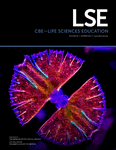Checking Equity: Why Differential Item Functioning Analysis Should Be a Routine Part of Developing Conceptual Assessments
Abstract
We provide a tutorial on differential item functioning (DIF) analysis, an analytic method useful for identifying potentially biased items in assessments. After explaining a number of methodological approaches, we test for gender bias in two scenarios that demonstrate why DIF analysis is crucial for developing assessments, particularly because simply comparing two groups’ total scores can lead to incorrect conclusions about test fairness. First, a significant difference between groups on total scores can exist even when items are not biased, as we illustrate with data collected during the validation of the Homeostasis Concept Inventory. Second, item bias can exist even when the two groups have exactly the same distribution of total scores, as we illustrate with a simulated data set. We also present a brief overview of how DIF analysis has been used in the biology education literature to illustrate the way DIF items need to be reevaluated by content experts to determine whether they should be revised or removed from the assessment. Finally, we conclude by arguing that DIF analysis should be used routinely to evaluate items in developing conceptual assessments. These steps will ensure more equitable—and therefore more valid—scores from conceptual assessments.



